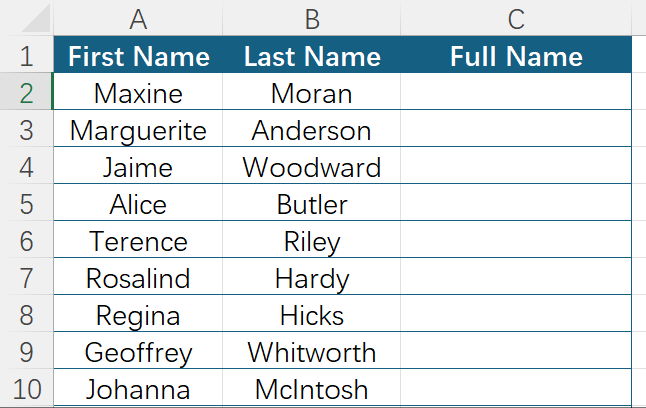You will often need a single Full Name column instead of separate First and Last columns. Typical cases include:
- Mail merges and labels, where Word or your label printer expects one Full Name field
- Learning platforms and certificates, which generate names from rosters
- CRM, HR, or ATS imports that accept only one name field
- Email display names or aliases you need to generate in bulk
- Data matching and joins where one dataset has a single Full Name field
- Event badges, guest lists, or seating charts that sort by a single name column
- E‑commerce exports to couriers that expect one contact name field
Below are fast, reliable ways to combine names for all rows at once, plus tips to clean the result.
Sample data setup
Assume:
- A2:A contain First Name
- B2:B contain Last Name
- You want the Full Name in column C, starting at C2

Fastest formula for most cases
If you simply need “First Last”:
- In C2:
=A2&" "&B2 - Fill down by double‑clicking the small square at the bottom right of C2, or drag it down
To automatically remove stray spaces from either column:
- In C2:
=TRIM(A2&" "&B2)
To fix inconsistent capitalization as you combine:
- In C2:
=PROPER(TRIM(A2&" "&B2))
CONCAT and TEXTJOIN alternatives
Some people prefer function names over the ampersand approach.
- CONCAT:
- In C2:
=CONCAT(A2," ",B2)
- In C2:
- TEXTJOIN, which can ignore blanks:
- In C2:
=TEXTJOIN(" ", TRUE, A2, B2) - The second argument TRUE tells Excel to ignore empty cells, which helps if some rows are missing last names or first names
- In C2:
If you also have a middle name in column C and want to include it when present:
- In D2:
=TEXTJOIN(" ", TRUE, A2, C2, B2)
Flash Fill (no formulas)
If you prefer a one‑time, no‑formula result:
- In C2, type the full name as you want it to look, for example: John Smith
- In C3, start typing the next full name. Excel will suggest the pattern for the remaining rows
- Accept with Enter, or use Data > Flash Fill
Flash Fill is quick for clean data. If your source columns change later, you will need to reapply it.
Helpful variations
- Last, First:
=B2&", "&A2 - Last.First email alias:
=LOWER(B2&"."&A2&"@yourcompany.com") - Protect against extra spaces in inputs:
=PROPER(TEXTJOIN(" ", TRUE, TRIM(A2), TRIM(B2))) - Convert formulas to values once you are done: copy the Full Name column, then Home > Paste > Paste Values
When AskExcel is the smarter choice
For simple joins, any formula above is perfect. When your data has real‑world messiness at scale, AskExcel saves hours:
- Clean and standardize names in bulk, including trimming, fixing double spaces, normalizing case, and preserving capitalization like “McCoy” or “O’Neil”
- Handle middle names, suffixes, prefixes, and hyphenated or multi‑part last names without writing nested formulas
- Auto‑generate the best approach for your Excel version, whether that is formulas, a Power Query script, or an Office Script for automation
- Validate results, flag suspicious entries, and export a clean Full Name column ready for mail merges, CRMs, or couriers
Try prompts like:
Create a Full Name column from First and Last, ignore blanks, trim extra spaces, proper case the output, and keep suffixes at the end.Upload your sheet to AskExcel, preview the transformation, and download the cleaned file or paste the generated formula directly into Excel. It is the quickest path from messy names to production‑ready outputs.
